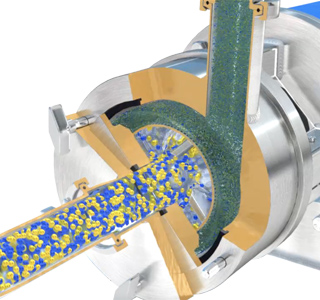Preparation of Drilling Fluids
Drilling fluids (or drilling muds) have several functions, including carrying bore cuttings to the surface, cooling and lubricating the drill “string” and controlling subsurface pressures.
A simple water based mud for horizontal drilling and some vertical operations consists of clay (bentonite) dispersed into water. In deep wells where the potential pressure of gas/oil dictates a heavier product, inert solids such as barite or hematite are added to weight the bentonite suspension. Muds based on a water/oil emulsion (known as “inverts”) are used for drilling deeper wells as they have better lubricating properties and are more temperature stable than water based muds. Traditionally diesel was used for inverts, however environmental concerns are leading to the use of low toxicity mineral oils, synthetics and esters.
Xanthan gum is increasingly used as a rheology modifier, due to the high viscosity that can be obtained with small percentages of gum. Another advantage of xanthan gum is the increased stability it provides with muds based on water or brine.
Waste management practices such as re-injection of fluid into redundant wells or transport to shore for remediation are increasing.
The video below shows how to disperse Bentonite, an ingredient widely used in drilling muds:
The Process
Barite is highly abrasive and close clearance rotor/stator mixers are not suitable for the dispersion of this material. This report covers the dispersion and hydration of the bentonite and other rheology modifiers (where used) into water or brine and the preparation of water/oil emulsions. To achieve these tasks, a number of process requirements must be satisfied:
- Mixing equipment must be capable of rapidly incorporating and dispersing powders into the water.
- The bentonite particles must be reduced to their finest constituent parts to expose the maximum surface area to the surrounding liquid and activate the gelling effect.
- A degree of shear is required to obtain functionality.
- Vigorous in-tank movement must be maintained as the viscosity rises.
- If the product is based on a water/oil emulsion, the mixer must be capable of sufficiently reducing droplet size to produce a stable emulsion.
The Problem
The following problems can be encountered when using conventional agitators:
- On addition to the water, the particles tend to agglomerate. The washing action of conventional mixers cannot break these down effectively.
- Conventional agitators do not produce sufficient shear to reduce particle size and activate the gelling effect.
- To overcome this, extra mix tanks may be required to allow the bentonite to pre-hydrate. Generally this process requires a minimum of 4 hours.
- A water/oil emulsion (where used) can separate out if not properly mixed and stabilised.
The Solution
A Silverson high shear mixer can overcome these problems, producing an agglomerate-free product and/or a stable water/oil emulsion in a fraction of the time taken by conventional methods. Operation is as follows:

Stage 1
The high speed rotation of the rotor creates a powerful suction which draws the water and bentonite into the workhead where they are subjected to intense high shear.

Stage 2
The materials are subjected to a milling action in the gap between the rotor and stator, breaking down agglomerates and ensuring intimate contact between the liquid and solid particles.

Stage 3
The product is forced out through the stator as fresh material is drawn into the workhead. The combination of deagglomeration and vigorous mixing produces a lump-free dispersion and accelerates the hydration process.
-
Stage 1

Stage 1
The high speed rotation of the rotor creates a powerful suction which draws the water and bentonite into the workhead where they are subjected to intense high shear.
-
Stage 2

Stage 2
The materials are subjected to a milling action in the gap between the rotor and stator, breaking down agglomerates and ensuring intimate contact between the liquid and solid particles.
-
Stage 3

Stage 3
The product is forced out through the stator as fresh material is drawn into the workhead. The combination of deagglomeration and vigorous mixing produces a lump-free dispersion and accelerates the hydration process.
The Advantages
- Easily retrofitted to existing plant.
- The intense shearing action of the rotor/stator workhead breaks down even hard agglomerates.
- Rapid powder dispersion.
- High rotor tip speed reduces process time.
- Increased yield.
- Bypassing the intense high shear action of the rotor/stator assembly is impossible.
- Finely reduced globule size ensures a stable oil/water emulsion is obtained.
- The In-Line mixer concentrates its efforts on the relatively small volume within the workhead rather than the entire batch, a more energy efficient process.
Drilling muds can be produced using an In-Line mixer on a recirculation basis but modified Flashmix powder/liquid mixing systems can also be supplied for continuous single-pass production of muds; these tend to be used for onshore drilling of pipelines.
High Shear In-Line Mixers
- Must be used in conjunction with an efficient agitator to wet out powders and ensure in-tank uniformity
- Ideal for larger batches
- Aeration free
- Easily retrofitted to existing plant
- Self-pumping
- Can be used to discharge vessel, depending on product viscosity
- Multistage units available
Silverson Flashmix
- Drilling muds can be instantly produced to order
- Up to 40 tonnes/hour can be produced, reducing storage requirements
- Capable of rapidly incorporating large volumes of powders
- Minimised cleaning requirements
- Minimum operator input required
- Ideal for larger batches
- Minimised aeration
- Suitable for higher viscosity mixes
- Suitable for operation at higher temperatures

